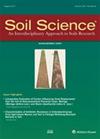在一个极度干旱的磷矿中,只有少数细菌在自然和开采后的生物壳中湿润后生长
4区 农林科学
Q2 Agricultural and Biological Sciences
引用次数: 0
摘要
摘要生物土壤结皮是荒漠生态系统功能的重要贡献者,因此,机械扰动后的生物结皮修复势在必行。在内盖夫沙漠极度干旱地区,磷矿开采已经进行了60多年,破坏了土壤栖息地,破坏了景观。在本研究中,我们选择了2007年恢复的一个矿区,利用DNA稳定同位素探测(DNA- sip)来确定在开采后及其邻近的自然生物结壳中生长的细菌。由于生物壳群落只有在湿润后才会激活,因此我们在环境条件下用h218o培养生物壳96 h。然后,我们评估了土壤的理化性质、叶绿素a浓度、活化和生物结壳的功能潜力。DNA-SIP分析显示,两种样地类型的细菌活性都很低,并且在比较采矿后和自然生物结壳时,增殖群落的组成没有显著差异。我们进一步发现,在微生物功能潜能、光合速率或土壤特性方面没有显著差异。我们的研究结果表明,湿润后超干旱生物结壳细菌的生长是最小的。我们假设,由于恶劣的气候条件,在湿润期间,细菌通过专注于损伤修复和有机化合物合成和储存而不是生长,将其微薄的资源用于为即将到来的干旱做准备。这些低增长率导致在诸如采矿等重大干扰之后,沙漠生物外壳恢复缓慢。因此,我们的研究结果强调了在采矿后实施积极恢复措施的必要性。本文章由计算机程序翻译,如有差异,请以英文原文为准。
Only a minority of bacteria grow after wetting in both natural and post-mining biocrusts in a hyperarid phosphate mine
Abstract. Biological soil crusts (biocrusts) are key contributors to desert ecosystem
functions, therefore, biocrust restoration following mechanical disturbances
is imperative. In the Negev Desert hyperarid regions, phosphate mining has
been practiced for over 60 years, destroying soil habitats and fragmenting
the landscape. In this study, we selected one mining site restored in 2007,
and we used DNA stable isotope probing (DNA-SIP) to identify which bacteria
grow in post-mining and adjacent natural biocrusts. Since biocrust
communities activate only after wetting, we incubated the biocrusts with
H218O for 96 h under ambient conditions. We then evaluated the
physicochemical soil properties, chlorophyll a concentrations, activation,
and functional potential of the biocrusts. The DNA-SIP assay revealed low
bacterial activity in both plot types and no significant differences in the
proliferated communities' composition when comparing post-mining and natural
biocrusts. We further found no significant differences in the microbial
functional potential, photosynthetic rates, or soil properties. Our results
suggest that growth of hyperarid biocrust bacteria after wetting is minimal.
We hypothesize that due to the harsh climatic conditions, during wetting,
bacteria devote their meager resources to prepare for the coming drought, by
focusing on damage repair and organic compound synthesis and storage rather
than on growth. These low growth rates contribute to the sluggish recovery
of desert biocrusts following major disturbances such as mining. Therefore,
our findings highlight the need for implementing active restoration
practices following mining.
求助全文
通过发布文献求助,成功后即可免费获取论文全文。
去求助
来源期刊

Soil Science
农林科学-土壤科学
CiteScore
2.70
自引率
0.00%
发文量
0
审稿时长
4.4 months
期刊介绍:
Cessation.Soil Science satisfies the professional needs of all scientists and laboratory personnel involved in soil and plant research by publishing primary research reports and critical reviews of basic and applied soil science, especially as it relates to soil and plant studies and general environmental soil science.
Each month, Soil Science presents authoritative research articles from an impressive array of discipline: soil chemistry and biochemistry, physics, fertility and nutrition, soil genesis and morphology, soil microbiology and mineralogy. Of immediate relevance to soil scientists-both industrial and academic-this unique publication also has long-range value for agronomists and environmental scientists.
 求助内容:
求助内容: 应助结果提醒方式:
应助结果提醒方式:


